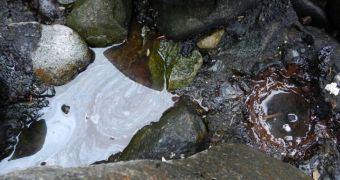Speaking at the 2014 Ocean Sciences Meeting in Honolulu, Hawaii, researchers announced that small pockets of oil originating from the 1989 Exxon Valdez spill could still be found along Alaska's coast.
For those unaware, the 1989 Exxon Valdez oil spill translated into about 11 million gallons (roughly 40 million liters) of oil being dumped in Prince William Sound in the Gulf of Alaska.
The incident used to be referred to as the largest spill in the history of the United States, but it lost its “crown” in 2010 to the Deepwater Horizon disaster which leaked 200 million gallons (750 million liters) of oil in the Gulf of Mexico.
The oil pockets from the Exxon Valdez spill that scientists claim to have recently stumbled upon in Alaska sit along the Shelikof Strait coastline.
This region is located southwest and at a distance of several hundred kilometers from the site of the spill, specialists explain on the official website for the American Geophysical Union.
They further detail that the 25-year-old oil that they discovered in said area is currently hidden behind boulders. All things considered, this is probably why its chemical makeup has not changed all that much since the spill until present day.
Thus, researchers theorize that, thanks to the rocks concealing it, the oil has remained safe from weather conditions and other environmental elements that would have probably caused it to break down.
“To have oil there after 25 years is remarkable. We have these marked boulders whose movement we've been studying for more than 18 years. The oil itself has hardly weathered and is similar to 11-day-old oil,” Gail Irvine of the U.S. Geological Survey's Alaska Science Center says.
These remnants of the 1989 Exxon Valdez spill were discovered during an investigation into how oil behaves and persists after working its way into the environment one way or another.
In order to determine that the newly discovered oil pockets do in fact originate from said spill, scientists looked at a series of particularities of their chemical makeup.
Due to the fact that oil extracted from different regions has a very specific makeup, specialists were able to use the pockets' so-called chemical fingerprints to pin down their source.
Commenting on the discovery of these 25-year-old oil pockets along the Shelikof Strait coastline, researcher Christopher Reddy with the Woods Hole Oceanographic Institution in Massachusetts stated as follows:
“One lesson is that if you are responsible for cleaning up a spill, you want to be proactive about cleanup behind the boulders.”

 14 DAY TRIAL //
14 DAY TRIAL //